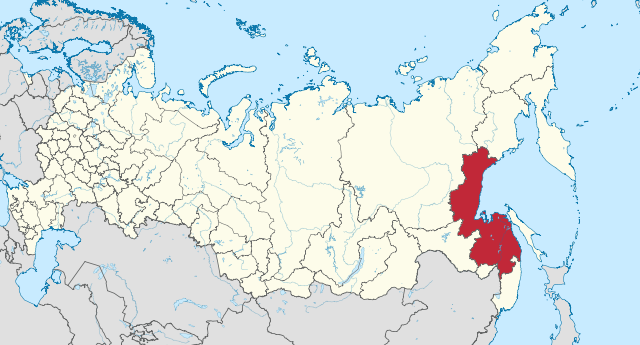From Wikipedia, the free encyclopedia
Khabarovsk Krai (Roushie: Хаба́ровский край, Khabarovsky kray) is a federal subject o Roushie (a krai), locatit in the Roushie Far East. It lies maistly in the basin o the lawer Amur River, but an aa occupees a vast muntainous aurie alang the coastline o the Okhotsk Sea, an airm o the Paceefic Ocean. The admeenistrative center o the krai is the ceety o Khabarovsk. The indigenous fowk o the aurie are the Evenks, Negidals, Ulchs, Nanai, Oroch, Udege, an Amur Nivkhs.[1]

Accordin tae various Cheenese an Korean records, the soothren pairt o Khabarovsk Krai wis oreeginally occupee'd ane o the five semi-nomadic Shiwei, the Bo Shiwei tribes an the Black Watter Mohe tribes livin respectively on the wast an the east o the Bureinsky an the Malyi Khingan ranges.
In 1643, Vassili Poyarkov's boats descendit the Amur, returnin tae Yakutsk bi the Sea o Okhotsk an the Aldan River, an in 1649–1650 Yerofey Khabarov occupied the banks o the Amur. The resistance o the Cheenese, housomeivver, obliged the Cossacks tae quit thair forts, an bi the Treaty o Nerchinsk (1689) Roushie abandoned her advance intae the basin o the river.
Awtho losin the richts tae navigate the Amur River, the Cheenese Qing Dynasty, housomeivver, niver claimed the lawer courses o the river. Nikolay Muravyov insistit on conductin an aggressive policy wi Cheenae bi claimin that the lawer reaches o the Amur River belang tae the Roushies.
Later in 1852, a Roushie military expedeetion unner Muravyov explored the Amur, an bi 1857 a chain o Roushie Cossacks an peasants wur settled alang the whole course o the river. The accomplished fact wis recognised bi Cheenae in 1858 bi the Treaty o Aigun, recognised the Amur River as the bundary atween Roushie an Qing Empire, an grantit Roushie free access tae the Paceefic Ocean.
Khabarovsk Krai shares its borders wi Magadan Oblast in the north, wi the Sakha Republic an Amur Oblast in the wast, wi the Jewish Autonomous Oblast, Fowkrepublic o Cheenae, an Primorsky Krai in the sooth, an is leemitit bi the Sea o Okhotsk in the east. It is the fowert-lairgest federal destrict athin the Roushie Federation, wi a comparative land aurie slichtly lairger than that o the U.S. state o Texas.
Taiga an tundra in the north, swampy forest in the central depression, an deciduous forest in the sooth are the naitural vegetation in the aurie.
Khabarovsky Krai is the maist industrialized territory o the Far East o Roushie, producin 30% o the tot industrial products in the Far Eastren Economic Region. The machine construction industry consists primarily o a heichlie developed military-industrial complex o lairge scale aircraft an ship biggin enterprises.[2] The Komsomolsk-on-Amur Aircraft Production Association is currently ane o amang Khabarovsk Krai's maist successfu enterprises, an for years haes been the lairgest taxpayer o the territory.[2] Ither major industries include timberwirkin an fishin, alang wi metallurgy in the main ceeties, awtho the krai's awn mineral resoorces are poorly developed. Komsomolsk-on-Amur is the iron an steel centre o the Far East; a pipeline frae northren Sakhalin supplees the petroleum-refinin industry in the ceety o Khabarovsk. In the Amur basin, thare is an aa some cultivation o wheat an soybeans. The caipital ceety, Khabarovsk, is at the junction o the Amur River an the Trans-Siberian railway.

Accordin tae the 2002 Census, 89.8% o the population are Roushies, 3.4% Ukrainians, 0.77% Nanais, 0.76% Tatars 0.66% Koreans an 0.62% Belaroushies.
In addition tae the Nanai, ither indigenous groups include the Evenks an Evens in the northren pairt o the province, an Ulchs in the lawer Amur river (Ulchsky Destrict). Some Nivkhs (Gilyak), an indigenous fishin fowk speakin an isolate leid, live aroond the Amur river delta as well. Smawer groups indigenous tae the aurie are Negidals (567), Orochs (686), an Udege (1,657) accordin tae the 2002 census.
Birth rate for 2008 is 5.2% heicher than that in 2007 an daith rate is 1.4% lawer. Birth rate wis recordit at 11.6 for 2007 (11.1 for Urban auries an 13.8 for Rural aurieas). Daith rate wis 14.2 in 2007 (14.3 for Urban auries an 14.0 for Rural auries). Rural locations o Khabarovsk Krai haed a positive naitural growthe o population in 2008 (For the first time in the last 16 year).[4]
Thare are the follaein institutions o heicher eddication in Khabarovsk Krai.[5][6]
Seamless Wikipedia browsing. On steroids.
Every time you click a link to Wikipedia, Wiktionary or Wikiquote in your browser's search results, it will show the modern Wikiwand interface.
Wikiwand extension is a five stars, simple, with minimum permission required to keep your browsing private, safe and transparent.